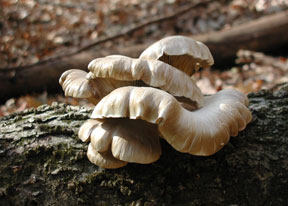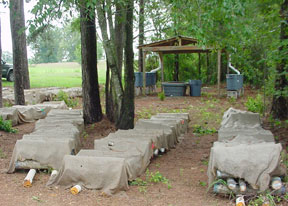What Type of Mushrooms to Grow for Profit
Growing Mushrooms for Profit
Marina D'Abreau Denny, Extension Acquaintance
Published 2/20/2014

Of all the enterprise opportunities for individual landowners, mushroom growing has the potential for the fastest render with the everyman fiscal investment and minimal space needed. Specialty mushrooms typically sell at wholesale prices of $3 to $6 per pound.
Several specialty type mushrooms are grown and sold in the United states of america, including oyster, shiitake, maitake, and lion's mane. Shiitake and oyster mushrooms are the all-time pick for pocket-sized-scale production, since they don't require a lot of equipment and space.
Shiitake mushrooms are often sold in grocery stores, health food stores, and farmers' markets and are too quite pop for their flavor and consistency. Oyster mushrooms are easy to grow and can be harvested in as little as 6 weeks.
Growing Shiitake and Oyster Mushrooms

Probably the easiest substrate on which to grow either shiitake or oyster mushrooms are pocket-size-diameter hardwood logs. The disadvantage to growing on logs is that the mushrooms will only be available for harvest seasonally. Other growing media, like sawdust or hay, can provide a twelvemonth-round supply of mushrooms.
Shiitake mushrooms can grow on iii-foot long logs, and a unmarried log may bear upwards to five crops of mushrooms. While oak is the preferred species, but beech, chestnut and other hardwoods piece of work just as well.
During common cold months, greenhouses and converted farm buildings tin be used for mushroom production. If you plan on doing outdoor production (platonic for spring and fall), the logs need to be inoculated with spawn (a starter mix of fungal mycelium and sawdust or grain), covered with shade cloth, and set bated to allow the fungi to develop. Spawn tin can take anywhere from 6 to 18 months to develop, depending on the log species, diameter, moisture, and temperature. At the end of this development flow, transfer the logs to a cool, moist surface area where the mushrooms tin abound and be harvested.
Oyster mushrooms are also best when grown on hardwood logs, simply many growers will opt for artificial substrates, such as composted harbinger, chopped wheat straw with cottonseed hulls, and sawdust, which is so placed in sealed plastic numberless, bottles, trays, or beds in a controlled surround later on sterilization and the addition of spawn. In about 100 ft2 of growing area, you can produce as much equally 2,500 pounds of mushrooms a year. Even selling at the low-finish wholesale toll of $3 a pound, that'due south a potential of gross revenues of $7,500 a year, before subtracting production, management, and labor costs. An added benefit of oyster mushrooms is that they freeze or dry out quite well, so if you can't sell your entire harvest right away, freezing or drying enables y'all to sell your oyster mushrooms days or months in the futurity.
Selling Your Mushrooms
It's of import that you sympathise not only the ins and outs of mushroom growing, but marketing strategies to brand the most of your production. A starting list of things to consider includes:
- health and legal matters
- Pest Control
- Market Potential for your mushrooms
Health and Legal Matters
Many commercially bachelor mushrooms are rich in proteins, vitamins, and minerals and are depression-fatty. There are also claims that certain species have the potential to fight cancer and viruses and reduce cholesterol and the gamble of heart disease.
Still, use caution when choosing which blazon of mushroom to grow or when deciding how to market your mushrooms. Hard-cadre, scientific evidence for their utilise as a "miracle food" is often sketchy, at best. Don't utilize unsupported wellness claims in your marketing to avoid being accused of faux advertising. Make certain that you are fully enlightened of all local, state, and federal laws regarding production and marketing of food products, and meet or exceed them.
If your mushroom concern grows to the bespeak that yous demand to hire outside employees, be certain that you provide the appropriate safety equipment, such every bit masks or respirators, to protect them from fungal spores. Oyster mushrooms, for example, produce spores that may cause allergic reactions in some people.
There is too the potential gamble of being sued by a consumer who becomes ill and claims that y'all sold them contaminated produce. Reduce your liability risks by
- ensuring your growing substrates are costless of pesticides and other toxins
- using only high-quality spawn from commercial suppliers
- maintaining clean growing environments
- keeping top-notch production records
- investing in liability insurance
Pest Control
Whether y'all choose to abound your mushrooms indoors or out, y'all'll need to control for pests and diseases. Fifty-fifty modest temperature or climate fluctuations tin reduce yields or spur the growth of "weed molds" which tin can decay the wood on which the mushrooms are growing. Insects, such as termites, bark beetles and springtails, and wildlife, including slugs, snails, birds, squirrels, and deer, can become serious pests for mushroom farmers, especially with outdoor operations.
Indoors, you lot'll need a certain degree of technical expertise to operate and maintain proper environmental controls. Growing facilities must be kept clean to avoid introduction of potentially toxic contaminants. Pests similar fungus gnats can be a common trouble and need to be managed appropriately.
Market place Potential
If you're non comfortable meeting with people and "selling your wares," then this part of the process will be the most difficult. Your main outlets to which to sell your mushrooms will be restaurants, farmers' markets, and grocery stores.
Visit local restaurants and offer free samples (along with a potential recipe or two) to the chefs. The prospect of promoting dishes made with locally-grown produce tin can be quite appealing. Be sure to enquire a lot of questions of your potential customers, including:
- Are they interested in locally-grown, fresh mushrooms?
- Do they have a preference for shiitake, oyster, etc.?
- Would they prefer weekly deliveries?
- How many mushrooms a week would they likely desire?
Nigh customers at farmers' markets are looking for quality foods from local growers, and then you're liable to sell quite a bit in a weekend. Enquiry the space availability and vendor rules of the farmers' markets in your surface area, and determine the benefits of selling at several over a wider geographic range, or just 1 or two nearby.
Grocery stores will often purchase their mushrooms from out-of-state distributors. Speak to the manager of your local store to determine if your product has a gamble of being sold in that location. Stress the fact that nigh mushrooms taste improve when fresh picked, which is an reward of your production over those shipped in from elsewhere.
Source: https://www.naturalresources.msstate.edu/articles/mushrooms.php